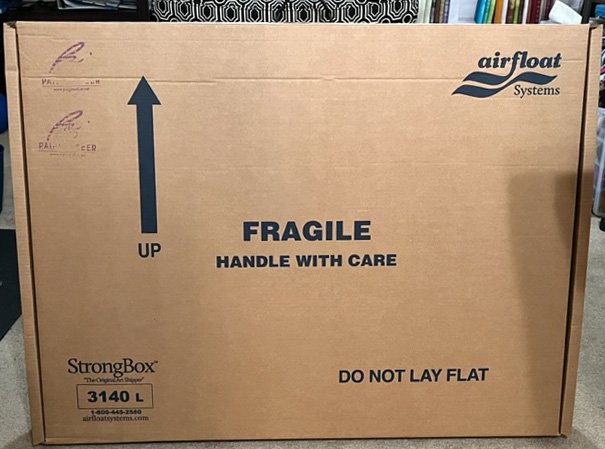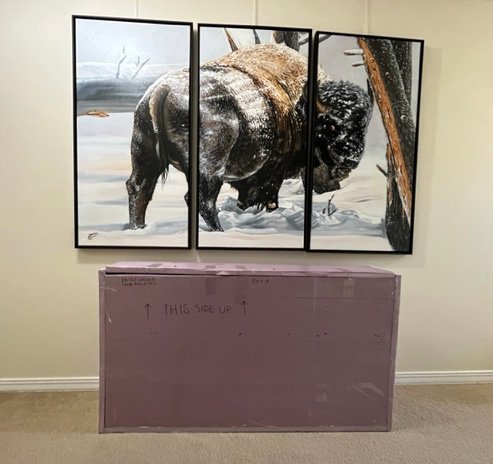Do you want to ship your artwork but need help figuring out where to begin? Whether you are an art collector or a painter looking for best practices, this article aims to help you safely get your artwork to the destination.
Here are five essentials to know when sending artwork:
1. Use Art Shipping Boxes
These boxes are an investment but well worth it. Invest in sturdy, purpose-built art shipping boxes that properly protect your artwork. These boxes are rigid, with reinforced corners and internal padding to safeguard against damage during transit. Make sure the artwork fits snugly inside the box to prevent movement.
Here are three online stores where you can buy art shipping boxes:
Uline
Picture Frame Boxes, Artwork Shippers, Art Boxes in Stock – ULINE
Airfloat Strongboxes
Masterpak Art Shipping Containers

Art shipping boxes are a good investment when shipping paintings to art shows.
2. Secure Framed Artwork
Use corner protectors and bubble wrap for framed artwork to secure the frame and protect it from potential impact. For the DIY-minded or the artist on a budget, you can also use custom-made foam inserts, dollar-store pool noodles cut in half, or pipe insulation found at the hardware store to keep the artwork from shifting inside the box.

Pool noodles are great for using to protect corners of artwork. Find them at Target or at dollar discount stores.
3. Wrap Unframed Artwork Properly
Always cover unframed art with glassine paper or acid-free tissue to protect it from scratches and moisture. Then, sandwich the artwork between sturdy cardboard or foam boards and seal the edges with tape. You may even want to place artwork in a waterproof bag as a final precaution.
I once heard a horror story about a painting (in a box) blown into a wet field during a storm. When the package’s owner discovered it, the artwork was preserved thanks to the plastic wrapping. The box wasn’t as lucky.
4. Utilize Bubble Wrap and Packing Peanuts
Visit your local Uhaul or shipping retailer; use bubble wrap to provide an extra cushioning layer around the artwork within the shipping box. Fill any remaining space in the box with packing peanuts, shredded paper, or crumpled packing material to minimize movement and absorb shock during transportation.
5. Label Fragile and Handle with Care
Clearly label the package as “Fragile” and “Handle with Care” to alert shipping carriers and handlers to exercise caution. Additionally, indicate which side of the box should face up to ensure proper orientation during handling.
(I designed personalized “fragile” shipping tape using Stickermule. It also includes my website address.)

Custom Shipping Tape
BONUS TIP
Insurance and Tracking: If the artwork is valuable or sentimental, consider purchasing shipping insurance to cover any potential damage or loss during transit. Always opt for a shipping service that provides tracking, so you can monitor the package’s journey and be informed of its delivery.

Additional Considerations When Shipping Your Paintings and Artwork
There are several other important considerations you might want to know to ensure a smooth and successful shipping process. Here are some additional points to keep in mind:
Shipping Restrictions and Regulations
Different countries and even states may have specific regulations and restrictions on shipping artwork, especially if it contains materials like ivory, certain woods, or other protected substances. It’s essential to research and comply with these regulations to avoid any legal issues.
Custom Packaging
Depending on the type and size of the artwork, you might need to create custom packaging solutions. Large or unusually shaped artwork may require specially designed crates to provide adequate protection during shipping.

For large or specialty sizes you may want to create your own custom artwork boxes.
Temperature and Climate Concerns
Extreme temperatures or high humidity levels during shipping can potentially damage artwork, especially if it’s sensitive to environmental changes. Consider using climate-controlled shipping services for valuable or delicate pieces.
Use a Shipping Service That Specializes in Transporting Artwork
Recently, I discovered the shipping company iTransport4u. They specialize in transporting artwork only. They even offer wrapping and packing services.
International Shipping and Customs
When shipping artwork internationally, you’ll need to deal with customs procedures and documentation. It’s crucial to properly declare the value of the painting and fill out the necessary customs forms accurately.

Artwork Insurance
As mentioned earlier, shipping insurance is essential for valuable artwork. Look into insurance options that cover potential damage, loss, or theft during transit.
Shipping Methods
Different shipping methods have varying delivery times and levels of handling care. Consider the urgency of the shipment and choose a shipping method that aligns with your needs and budget.

📸 by Bannon Morrisy (@bannon15 on Unsplash)
Return Policy: If you’re shipping artwork for sale or exhibition, ensure you have a clear return policy. This will help avoid disputes or issues after the delivery.
Framed vs. Unframed
Packaging and shipping requirements differ between framed and unframed artwork. Make sure to handle and protect them appropriately based on their specific characteristics.
Documentation
Keep a detailed record of the artwork, its condition before shipping, and any prior repairs or restoration work. This documentation will be helpful in case of any shipping-related incidents or insurance claims.
Shipping Carriers
Research and compare shipping carriers to find one that suits your needs regarding cost, reliability, and handling of fragile items.
Shipping artwork can be a complex process, but with the right knowledge and attention to detail, you can significantly reduce the risks and ensure your precious creations reach their destination safely and intact.






